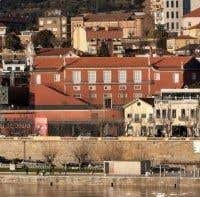Paul Symington of the eponymous and powerful port shippers sends this report of developments in northern Portugal. He could hardly be said to be impartial but most wine lovers should learn a great deal from his description of a new tourist destination in the Douro valley. Port should be in the news next month when the small but perfectly formed 2007 vintage ports are expected to be released.
Regua (pictured below) used to be a place that was only noteworthy for the fact that the train stops there in its way to the Upper Douro. Now it is worth going there for its museum. It is situated in a magnificent old building, that of the original Douro Wine Company that demarcated the region in 1756, making it the oldest demarcated and regulated wine region in the world. The opening exhibition is very good and is on Joseph James Forrester, Baron of Portugal. The organisers of the exhibition have found items and information about Forrester that is completely new to many of us. I certainly had no idea about some of it. 
Forrester came to Portugal in 1831 aged 22 and over a period of 30 years had an incredibly profound and controversial impact on the Douro and on port. He addressed committees of the House of Commons on questions to do with the port trade, was on the closest terms with the leading figures in Portuguese politics (many of whom he painted), he became a member of the Reform Club in London, exhibited at the Great Exhibition in London in 1851, and showed his wines, olive, oil and other items in the Paris Exhibition in 1855 to great acclaim.
It is well known that he made the remarkable map of the Douro which resulted in his being made a Baron. This map is a truly extraordinary achievement considering the limited resources available at the time. This is all very clear from this exhibition. But it is less well known that he was an accomplished painter and one of the earliest photographers. He set up a dark room in his house in Gaia to develop his pictures (this house has been our family’s offices since 1905).
The Museum has assembled many of his paintings and maps and other artefacts and they are all very well exhibited (see below), with all the information in both Portuguese and English. It is all well worth a visit. 
Forrester was highly opinionated on many issues (like many from Yorkshire and Scotland, which is where he was from) and must have been quite a difficult man sometimes, even though he was a visionary in many ways, very often right and well ahead of his time. At one stage he fell out with the established port companies, which included his uncle and his father-in-law, on questions to do with the regulation of the port trade. One particularly contentious issue was the addition of brandy to fortify the wines of the Douro and other ‘adulterations’, primarily resulting from the fact that during a long period of violent civil war then raging in Portugal, and corruption in the regulatory bodies of port, wine from outside the Douro was being added to real Douro port wine.
In 1852 he left the port shippers Offley Forrester (where my great-great grandfather John Atkinson worked for over 50 years, including with Forrester for several years) and set himself up as a ‘farmer-producer’, pre-dating both the emergence of the red wines of the Douro and the modern wave of farmer-producers by at least 150 years. He claimed that the wines of the Douro could compete with the best of the French and others, without fortification, or if any was needed, it need only be in a very small proportion. He changed his name from Joseph to José and became a well known and widely respected person in Oporto and the Douro.
He became a great personal friend of Dona Antonia Ferreira and lunched with her at Quinta do Vesuvio before starting the fateful descent on 12 May 1861 where he was drowned in the Douro. The ultimate irony is that there is a painting by him of Vesuvio, with himself and Antonio in the foreground, the very place where were he had his last lunch. Furthermore, there is a painting by him of the gorge where his boat overturned and died: the Cachão da Valeira between Vesuvio and Pinhão.
Many of the items on show have been lent by the Factory House, by the British Club in Oporto and by port houses (many of my family’s Forrester paintings are on show), as well as by many individuals from Oporto and the Douro.
There is a very good book published in Portuguese (over 300 pages) on the exhibition and on Forrester the man, but Fernando Maia Pinto, the excellent director of the museum, a good friend of mine, tells me that an English version will be available in May.
The Douro is changing. There are several new and good restaurants and new places to stay. So now it is not only the most beautiful wine growing region in the world, it has other attractions for visitors! The Douro is really becoming ‘The New Douro’ and we are getting close to the time where it will become a major destination for travellers.
